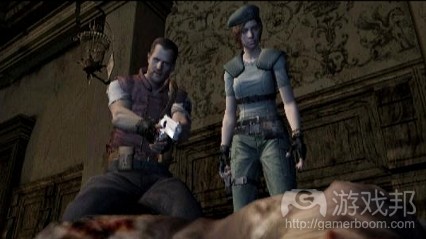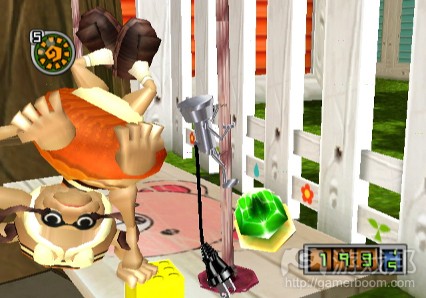日本游戏具有与西方文化不同的独特美学观念
作者:Slaktus
上一周,《刺客信条3》创意总监Alex Hutchinson指责西方游戏记者对劣质的日本游戏的批评是一种“微妙的种族歧视”行为。相关的报道文章吸引了大量评语,其中一条特别吸引眼球。我们邀请Slaktus——真名为Erlend Grefsrud——Strongman Games工作室的联合创始人撰文具体解释他的观点。下文不只是对Hutchinson意外言论的反驳,还是留下好评论的榜样。
“大伙们,日本完蛋了。”稻船敬二(《洛克人》开发者)叹惜道,无人吃惊。毕竟,他只是表达西文游戏媒体的普遍观点:日本开发商正在挣扎,他们的技术被超越了,他们的设计理念停滞不前。受美国和德国的技术推动,欧美游戏已经逼近登峰造极的境界:如照片般逼真的角色和世界。一旦达到这个程度,可以说,游戏就就展现了自己这种媒体创造剧情和无限沉浸感的潜能。
这种对游戏的创造和再造技术,再加上开发群体痴迷的定量指标——热点地图和生物统计学描绘着通向希望之地的路径,已经导致最终作品出现一定程度的同质化。随着越来越多差异性被抽离,游戏不断地重制,设计也越来越简化。
结果,以不变应万变的动作——双杆加触发器的控制组合现在成了主流,甚至实现了部分自动操作:聪明的算法按步就班地指挥角色越过障碍、跳过缝隙和抱紧墙头,玩家只需要转转眼球就行了。
《刺客信条》、《Enslaved》和《神秘海域》是这类无冲突美学的开拓者,它们之所以容易上手,不是因为技术上的独创性,而纯粹是熟能生巧。乏味的助力引擎满足于从玩家的作用域和角色代理模式中抽离动作快感,设计良好的剧情成了玩家体验的主要象征。
日本游戏,因为不模仿这类美学发展的模式,而被斥为低级作品。游戏画面不像照片般逼真,只有怪异的、忸怩的夸张的卡通风格。正如《刺客信条3》创意总监所说的,日本游戏没有“生动、鲜活的世界”或“游戏生态”,只有迟钝的、复杂的、过时的“胡扯”。日本游戏看似罪恶,因为它们不能迎合欧美审美,不能效仿《黑色洛城》的警察表演的复古风和《FIFA 12》式的电视播放足球赛。
这种文化沙文主义甚至达到了这种程度:西方游戏设计师觉得有必要执行作为游戏界权威的职责,指出日本游戏开发商在设计游戏和叙述剧情上的明显失败。然而这是毫无道理的!日本游戏设计是完全合理的,正如日本故事和视觉艺术传统一样,其建立基础是非常独特的美学观念,与西方文化传统缺少共同点。
考虑到第一代《生化危机》的“设计缺陷”:无用的和昏暗的摄像镜头视角,阻碍玩家看到关键的信息,玩家只能从迟钝的操作和有限的角色代理中得到补偿。累赘的操作组合不仅没有减轻战斗的压力,反而使之更加困难;而锁与匙的谜题让玩家感到受环境的控制,而这个环境本身又被荒谬的逻辑主导着。这正是生存恐怖游戏的压抑氛围制造的效果:这是系统响应由表层隐喻暗示的内容的形式。这赋予了系统本身以意义、目的。我认为这种系统才体现了交互作用的真正强大。这种系统的设计强化了剧情表达的主题,体现了主题的微妙之处。
《死亡空间》正是因为这个原因称不上是一款恐怖游戏。它的所有中心机制起的都是助力作用,从肢解怪物到时间扭曲和重力操纵的益智题。通过简化的助力作用,系统把引发恐惧感的任务丢给剧情的隐喻。
相反,《合金装备》的系统非常特别。游戏给玩家的操作方案充满令人不舒服的按键组合和奇怪的映射,例如,开火不是按下按钮,而是放开按钮。这意味着玩家角色的能力和处境体现在操作的精通上,而不是意愿的满足上。你按键的方式、将手指从触发器上松开的方式,意味着一点小动作也可能使一切都乱套;比如,手指滑落,可能对角色手中的枪来说就是有意义,之后,处境就突然且不自然地改变了。
另外,游戏戏统强化了该游戏系列对斗争的怀疑这一主题。用收音机拿下一个守卫、搜索队被派去加强保安措施。攻击搜索队,突击队遍地跑。通过扩大斗争局势而不是增加对玩家的威胁来解决危险情形,这种尝试颠覆了枪战在游戏中的传统作用。
相反,从《合金装备2》之后的系列开始,强调玩家与敌人之间的复杂交互作用,如用枪口挑起敌人当作人体盾牌。暴力的威胁比实际的暴力更有效果。将近战系统和强调手动操作的狙击瞄准分化开,增添了角色规避暴力的深度,避免了玩家从纯侵入式、无意义的暴力中获得乐趣。
除了战斗机制,《Chibi-Robo》体现了叙事框架如何使简单的、普通的交互活动产生意义。游戏以家庭为背景,玩法上无秩序,角色关系上不固定。扮演清洁机器人的玩家意识到这个家庭面临的真实问题,同样发现作为机器人,想帮助他们却也是有心无力。
游戏使玩家在解决中心斗争中处于无效的位置,这就在玩家的清洁工作中灌输了强烈的无力感,刺激玩家寻找方法颠覆《Chibi-Robo》狭碍的表达视野,以更有效地表达有助于解决家庭危机的事情。
那么《刺客信条》呢?该系列名义上是探索暴力文化和宗教斗争的影响,体现玩家作为古代刺杀和躲藏艺术的实际操作者。这款游戏被简化到没有乐趣的程度。特技场面实际上只体现了操作的精通,剧情基本上就是关于一个身怀绝技的年轻白人的传说。准备刺杀行动就是执行与剧情暗示的体验象征性地保持联系的任务,而刺杀本身不是通过诡计实现的,而是通过重复一系列量化的目标达到的。
《刺客信条》有点像斯金纳盒,是给“经济人”(游戏邦注:又称作“经济人假设”,即假定人思考和行为都是目标理性的,唯一试图获得的经济好处就是物质性补偿的最大化。这常用作经济学和某些心理学分析的基本假设)而非“游戏人”制作的,除了从目标达成和外在刺激物练就的熟悉操作模式中产生低层次的沉浸感,就没有任何意义了。它强调从结果和任意选择处理相同事件的方式中获得的空洞的自由,除了分支的叙事或非线性进程的外观存在差别。
虽然这是一个品味问题,但我发现富有表现力的系统能产生更真实、更多样的游戏美学。它们为探索娱乐超越满足心愿、能有效地传达隐喻这一主题提供了更强大的机遇。
这种设计理念可能对某些西方开发商来说已经过时了,但毫无疑问,它是有效的。我们应该赞美某些批评者的宽容,因为他们承认和尊重不同传统和理念;而不是责备他们认同某种发展形式超越其他发展形式。(本文为游戏邦/gamerboom.com编译,拒绝任何不保留版权的转载,如需转载请联系:游戏邦)
Japanese games aren’t gibberish – just different
by Slaktus
Last week, Assassin’s Creed III creative director Alex Hutchinson accused western game journalists of “subtle racism” by giving bad Japanese games an easy ride. Our story drew plenty of comments, and one in particular caught our eye. We asked Slaktus – real name Erlend Grefsrud, co-founder of London studio Strongman Games – to expand his comments to a full piece. What follows, then, is not solely a rebuttal to Hutchinson’s surprising views, but a fine example of the value of leaving good comments.
-
“Man, Japan is over,” sighed Keiji Inafune, surprising no-one. He was, after all, merely reflecting the prevailing narrative in the western games press: Japanese developers were struggling, their technologically surpassed, their design philosophy stagnant. Propelled by the finest in American and German engineering, western games have inched their way towards a mythical tipping point: a level of photorealism and world simulation fidelity that, when reached, would reveal the medium’s potential for human drama and unrestrained immersion.
This engineering and reengineering approach to game design, coupled with the development community’s obsession with quantitative metrics – heatmaps and biometrics charting a route to the promised land – have led to a certain homogenity in the resulting works. Games are constantly iterated on, growing ever more streamlined as more and more nuance is abstracted away.
What’s emerging is a one-size-fits-all kinaesthetic, the dual-stick-and-triggers control scheme now hegemonic, even partially automated: Clever algorithms send procedurally animated avatars clambering over obstacles, jumping gaps and hugging walls, requiring no more from the player than an expression of intent.
Assassin’s Creed, Enslaved and Uncharted are pioneers of this friction-free aesthetic, their accessibility derived from familiarity rather than ingenuity. Anodyne engines of empowerment, satisfied with abstracting kinaesthetics away from the player’s scope and mode of agency, making well-established cinematic and storytelling tropes the primary signifierof the player experience.
Japanese games, by not aping this particular model of aesthetic progress, are assumed to be inferior. Not photorealistic, but whimsy, cutesy, exaggeratedly cartoonish. Not “living, breathing worlds” or “ecosystems of play” but sluggish, complex, old-fashioned “gibberish”, as Assassin’s Creed III’s creative director put it. Japanese games, it seems, are guilty of failure to emulate western consumption spheres, the way LA Noire is to a retro cop show as FIFA 12 is to televised football.
This cultural chauvinism has reached the point where western game designers feel the need to pontificate about the apparently objective failure of Japanese game developers to design games and tell stories. Nonsense: Japanese game design is valid in entirely the same way as Japanese storytelling and visual art tradition is valid, founded on a very separate range of aesthetic ideals that share few parallels with the Western cultural traditions.
Consider the “design flaws” of the first Resident Evil games: unhelpful and often claustrophobic camera angles that obscured critical information from the player complemented by sluggish controls and limited agency. Cumbersome control schemes make combat a source of stress rather than relief, while lock-and-key puzzles impart a sense of being at the mercy of an environment governed by absurd logic. This is what conjures the oppressive atmosphere of survival horror: the form of the system corresponds with the content suggested by the surface metaphor. This gives a sense of meaning, of purpose, to the system itself, which I believe is the true strength of interactivity. The design of the system reinforces and provides nuance to the theme expressed by the fiction.
Dead Space fails as a horror game for precisely this reason. All of its central mechanics are empowering, from the little meta-game of monster amputation to its time-warping and gravity manipulation puzzle-solving. By striving for streamlined empowerment, the system leaves the task of conjuring compelling horror to the tropes in its fiction.
By contrast, the Metal Gear Solid games have very characteristic systems. Players are given a fiddly control scheme replete with uncomfortable key-press combinations, and idiosyncrasies such as firing shots not on the press but release of a button. This suggests something about the situation and ability of the avatar, making embodiment a matter of mastery rather than wish-fulfilment. The way you must press against walls, the way you ease your finger off the trigger suggest all the little things that can go wrong; a slip of the finger can be a meaningful action with a gun in your hand, after all, changing the situation in sudden, unexpected ways.
In addition, the game system reinforces the series’ motif of scepticism towards conflict. Take down a guard with a radio, and search teams are dispatched to tighten security. Attack the search team, and assault teams flood the area. Attempts to resolve threatening situations via escalation of conflict results instead in an escalation of the threat to the player, inverting gunplay’s traditional role in games.
Instead, from Metal Gear Solid 2 onwards the series emphasises complex interaction with enemies, from holding them up at gunpoint to using them as human shields. The threat of violence is more efficient than actual violence. The branching close-quarters combat system and the fiddly firstperson iron sight aiming lend depth of agency to the avoidance of violence, a solid counterpoint to the purely transgressive joy of consequence-free brutality.
Outside combat mechanics, Chibi-Robo demonstrates how narrative framing can lend significance to uncomplicated, mundane interactions. The family home where the game plays out is in disarray, its relationships in flux. The player is aware of the very real problems the family is facing, and is equally aware that as a mere cleaning robot, there’s little scope for helping them.
By daring to make the player’s scope of agency ineffective in resolving the central conflict, a poignant powerlessness imbues the player’s cleaning duties, motivating – making inevitable, even – the eventual shift in the game’s direction as the player starts looking for ways to subvert Chibi-Robo’s narrow scope for expression into something more effective, something that can resolve the family crisis.
What, then, of Assassin’s Creed? The series, which nominally explores the impact of violent cultural and religious conflicts and embodies the player as a practitioner of ancient arts of subterfuge and murder, is streamlined to the point of having no flavour. The acrobatic spectacle is reduced to a matter of fact rather than an expression of mastery, the narrative ultimately a tale of a young, white man living vicariously through mystical technology. Preparation for assassinations is a matter of performing tasks that only symbolically bear relation to the experience suggested by the fiction, while assassinations themselves are made possible not by cunning, but rote satisfaction of quantified goals.
Assassin’s Creed is a little Skinner box built for homo economicus, not homo ludens, imparting no meaning apart from the satisfaction of low-engagement goal attainment, extrinsic motivators shaping a workmanlike mode of play. It emphasises hollow liberation from consequences and freedom to choose an arbitrary number of ways to do the same thing, only differentiated by branching narrative or a facade of non-linear progression.
While it is a question of taste, I find that expressive systems with heavily authored modes of expression result in truer, more diverse aesthetics of play. They afford a more powerful opportunity for participation in the exploration of themesthat allow entertainment to transcend mere wish-fulfilment, enabling subtext to be a matter of effect as much as analysis.
This design philosophy may be unfashionable with certain western developers, but there is no question it is valid, and not a holdover given a free pass by nostalgic or lenient critics.
Instead, critics who recognise and respect different traditions and philosophies should be lauded for their tolerance, not blamed for failing to privilege particular forms of progress over others.(source:edge-online)









































 闽公网安备35020302001549号
闽公网安备35020302001549号